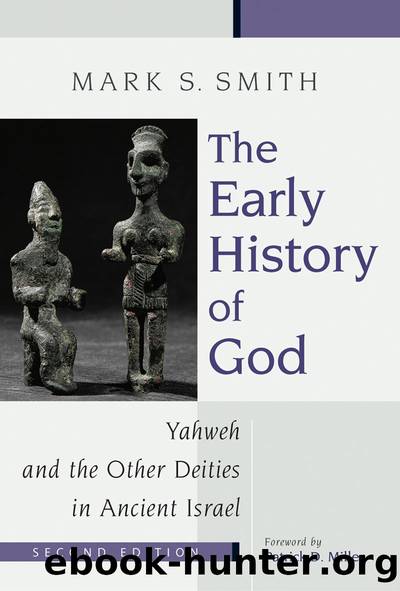The Early History of God: Yahweh and the Other Deities in Ancient Israel by Mark S. Smith

Author:Mark S. Smith [Smith, Mark S.]
Language: eng
Format: epub
Tags: Religion, Comparative Religion, history, Social Science, Sociology of Religion
ISBN: 9780802839725
Google: 1yM3AuBh4AsC
Publisher: Wm. B. Eerdmans Publishing
Published: 2002-08-03T00:12:44.940523+00:00
1. For secondary literature up to 1975, see Cooper, âDivine Names and Epithets in the Ugaritic Texts,â 350-52; see also M. H. Pope, âBaal Worship,â EncJud 4:7-12; R. Rendtorff, âEl, BaÊ¿al und Jahwe: Erwägungen zum Verhältnis von kanaanäischer und israelitischer Religion,â ZAW 78 (1966): 277-92; E. Gaál, âTuthmösis III as Storm-God?â Studia Aegyptica 3 (1977): 29-37; D. Kinet, BaÊ¿al und Jahwe: Ein Beitrag zur Theologie des Hoseabuches, Europaische Hochschulschriften 23/87 (Frankfurt/Bern: Lang, 1977); A. Saviv, âBaal and Baalism in Scripture,â Beth Mikra 29 (1983/84): 128-32 (Heb.). On Baal in sources prior to Ugaritic material, see K. Koch, âZur Entstehung der BaÊ¿al-Verehrung,â UF 11 (1979 = C. F. A. Schaeffer Festschrift): 465-79; G. Pettinato, âPre-Ugaritic Documentation of BaÊ¿al,â in The Bible World: Essays in Honor of Cyrus H. Gordon, ed. G. Rendsburg, A. Adler, M. Arfa, and N. H. Winter (New York: KTAV, 1980), 203-9; W. Herrmann, âBaal,â DDD, 132-39; cf. E. Sollberger, Administrative Texts Chiefly Concerning Textiles: L. 2752, Archiv Reali di Ebla Testi 8 (Rome: Missione Archeologica Italiana in Siria, 1986), 9-10.
2. See chapter 1, section 3.
3. On the Baal names in the Samaria ostraca, see Pope, âBaal Worship,â 11; R. Lawton, âIsraelite Personal Names on Pre-Exilic Hebrew Inscriptions,â Biblica 65 (1984): 332, 335, 341; I. T. Kaufman, âThe Samaria Ostraca: A Study in Ancient Hebrew Paleographyâ (Ph.D. diss., Harvard University, 1966); idem, âThe Samaria Ostraca: An Early Witness to Hebrew Writing,â BA 45 (1982): 229-39; Tigay, You Shall Have No Other Gods, 65-66. The names are ʾbbÊ¿l, âBaal/lord is fatherâ (2:4); bÊ¿lʾ, âBaal/lordâ (1:7); bÊ¿lzmr, âBaal/lord is strongâ (or âBaal/lord sings,â 12:2-3); bÊ¿lʾzkr, âBaal/lord remembersâ (37:3); and mrbÊ¿l, âBaal/lord is strong(?)â (2:7); cf. [t]á¹£bÊ¿l(?) in Mesad Hashavyahu (see Tigay, You Shall Have No Other Gods, 66). On the background of the ostraca, see also A. F. Rainey, âThe Sitz im Leben of the Samaria Ostraca,â TA 6 (1979): 91-94; cf. W. H. Shea, âIsraelite Chronology and the Samaria Ostraca,â ZDPV 101 (1985): 9-20. See also the Phoenician name bÊ¿lplá¹ from Tel Dan (J. Naveh, âInscriptions of the Biblical Period,â in Recent Archaeology in the Land of Israel, ed. H. Shanks and B. Mazar [Jerusalem: Biblical Archaeology Society and Israel Exploration Society, 1985], 64); the Hebrew name blntn (*bêl-nÄtan from *baÊ¿al-nÄtan) in an eighth-century Aramaic inscription from Calah (so Albright, âAn Ostracon,â 34 n. 15, 35). Albright interprets the theophoric element in this name as a title of Yahweh, but the name seems to be non-Yahwistic.
4. Pope, âBaal Worship,â 11-12. See also A. Rainey, âThe Toponyms of Eretz Israel,â BASOR 231 (1978): 1-17; B. Rosen, âEarly Israelite Cultic Centres in the Hill Country,â VT 38 (1988): 114-17.
5. Olyan, Asherah and the Cult of Yahweh, 6. For further discussion, see Y. Yadin, âThe âHouse of Baalâ of Ahab and Jezebel in Samaria, and that of Athalia in Judah,â in Archaeology in the Levant: Essays for Kathleen Kenyon, ed. R. Moorey and P. Parr (Warminster, England: Aris & Phillips, 1978), 127-35; cf. B. Halpern, ââThe Excremental Visionâ: The Doomed Priests of Doom in Isaiah 28,â Hebrew Annual Review 10 (1986): 117 n.
Download
This site does not store any files on its server. We only index and link to content provided by other sites. Please contact the content providers to delete copyright contents if any and email us, we'll remove relevant links or contents immediately.
Machine Learning at Scale with H2O by Gregory Keys | David Whiting(4190)
Never by Ken Follett(3796)
Fairy Tale by Stephen King(3220)
The Man Who Died Twice by Richard Osman(2997)
Reminders of Him: A Novel by Colleen Hoover(2952)
Will by Will Smith(2794)
Rationality by Steven Pinker(2291)
Can't Hurt Me: Master Your Mind and Defy the Odds - Clean Edition by David Goggins(2229)
It Starts With Us (It Ends with Us #2) by Colleen Hoover(2202)
Friends, Lovers, and the Big Terrible Thing by Matthew Perry(2123)
The Becoming by Nora Roberts(2089)
The Stranger in the Lifeboat by Mitch Albom(2050)
Love on the Brain by Ali Hazelwood(1965)
New Morning Mercies: A Daily Gospel Devotional by Paul David Tripp(1877)
HBR's 10 Must Reads 2022 by Harvard Business Review(1778)
The Strength In Our Scars by Bianca Sparacino(1777)
A Short History of War by Jeremy Black(1763)
Never Finished: Unshackle Your Mind and Win the War Within by David Goggins(1644)
515945210 by Unknown(1601)
